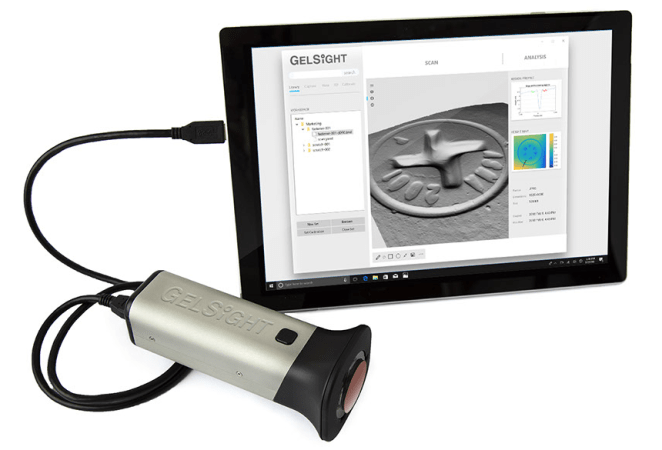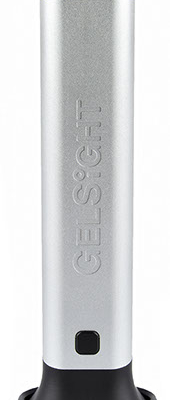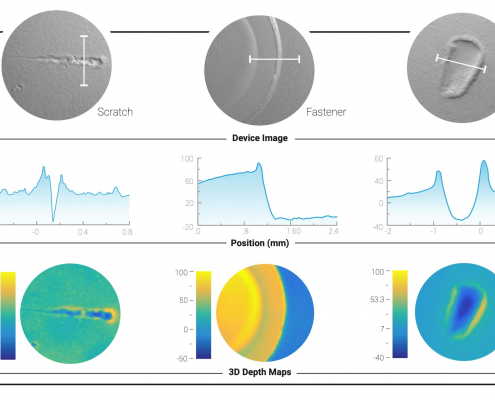The human finger is incredibly sensitive, with a dense array of receptors in the tip that allow us to feel features as small as nanometers. When Kimo Johnson visited aerospace companies that machine metal parts, he learned that many were relying on experienced workers to conduct a “fingernail test” to quickly judge whether a surface defect was just a small scratch or deep enough to potentially compromise the part.
Johnson’s Boston-area startup, Gelsight, aims to provide a more accurate but equally fast alternative with a handheld probe it’s developed. The tip contains a clear gel pad that, like our fleshy fingertips, can conform around an object. Using computer vision techniques, the system “turns touch into an image,” says Johnson, allowing it to map surface features in 3D and measure them down to the single-digit micron level.
The company is starting to get traction: A number of large aerospace companies are moving toward deploying the tool, Johnson says, including airplane engine maker Rolls-Royce.
Now Gelsight has raised $10 million in a B round that takes its total funding to $11.8 million. It’s expecting revenue to top $4 million this year on sales of over 100 systems and 2,500 gel cartridges.
While the 42-year-old Johnson hopes aerospace will be Gelsight’s breakthrough application, in the nine years since he co-founded the company based on his postdoctoral work at MIT, benchtop versions of its technology have been used for a wide array of tasks, including by Harvard researchers to map fish scales and cosmetics developers to measure how well a product filled in wrinkles.
Rolls-Royce is distributing the handheld device to service reps in its maintenance shops to assess engine parts for damage. Until now, to get an accurate measurement of scratches and dents in sometimes hard to reach places, Rolls and other companies have used a method akin to how dentists make molds of teeth, pressing a wet composite material against the spot that hardens, creating a negative of the defect that is sent off to a lab for cross-sectioning and measurement. It can take as much as 24 hours to get a result.
“We haven’t found another product that has the capability of Gelsight,” says Alistair Donaldson, a Rolls-Royce executive focused on innovation who’s helped the startup hone its technology for practical use. “I could put it in the hands of a child and he could take an accurate measurement.”
The device is based on work by MIT professor Edward Adelson, a specialist in computer vision who became fascinated by how the sense of touch worked while raising his children. After learning from colleagues that no one yet had developed an artificial tactile sensor with anywhere near the ability of human skin, Adelson set out to do so, leveraging his vision expertise.
“The concept was what would it look like if you had a camera inside your skin and you could see when something’s poking into your skin,” says Johnson, who joined Adelson’s lab as a post-doctoral fellow in 2008 after earning a Ph.D. in computer science from Dartmouth.
Adelson developed a clear pad made of a rubbery thermoplastic elastomer that was coated on one face with a metallic paint. When an object is pressed into the painted side, it takes on the object’s shape and presents a surface that a camera can easily capture a high-fidelity image of through the gel, without distortions from variations of reflective or transparent elements in the object. Johnson built the hardware and wrote algorithms to accurately map surfaces using image processing and machine learning techniques.
Along with a 2011 paper describing the system, Johnson published YouTube videos that caught wider attention, showing renderings of the complex geometry of an Oreo cookie and the raised structure of a printed letter on a $20 bill. He says that led the team to receive thousands of messages from companies and engineers asking if it could be used to measure everything from features of human skin to the quality of abrasives, and a visit by two Boeing engineers with a suitcase full of parts.
“That’s what prompted me to start this company,” Johnson says.
He launched Gelsight in 2011 with CTO Janos Rohaly, a former lecturer at MIT who cofounded a dental 3D imaging startup that was acquired by 3M, and former CEO Bill Yost. (Johnson has been CEO since 2016.) They made a series of one-off benchtop machines for corporate R&D departments with gel pads optimized for specific applications, such as a toothpaste maker that squished globs of paste to assess its mix of abrasives. But Johnson says he came to realize this approach was a dead end: each company generally only wanted one device that wasn’t widely saleable.
A cellphone manufacturer in China offered a bigger opportunity in mass production, asking Gelsight in 2015 to make a system that could check whether components like metal buttons were the right size. That led Johnson to an epiphany.
“We were making beautiful 3D maps of surfaces, but what the customer often wants is just a single number: What’s the depth of this feature, what’s the chamfer angle,” he says.
They began looking for other industries where a single measurement was needed, day in and day out. That led them to aerospace, particularly scratches and dents on high-value metal parts.
With the proceeds from the sales to the Chinese cellphone maker and lessons learned on what it took to make a system robust and simple enough to be used by ordinary workers, they made the handheld version of the device, debuting it in 2017.
“Now rather than a single customer we’ve got the entire aerospace market, and that gives us a much better ability to grow the company,” Johnson says.
Donaldson of Rolls-Royce says he could see hundreds of the $40,000 Gelsight handheld systems being used at his company. Gelsight also earns money on sales of replacement gel cartridges, which wear out after roughly a week of full-time use and go for $120 apiece.
In conjunction with the $10 million fundraising round, which was led by the venture capital firm Anzu Partners, Gelsight added two former high-ranking military aviation officers to its board to help it crack the defense market, where the pressure is intense to quickly inspect hard-used aircraft and get them back in the air. “If a stone hits the blade of a helicopter, you need to know if this thing can fly,” says Johnson.
With the fresh funding, Johnson aims to double Gelsight’s current headcount of eight and build a smaller version of the wand to get into tighter spaces. He’d like to make it the same size as a human finger. “People use their finger a lot in manufacturing to feel different spaces, if they could have a digital tool that’s a similar form factor, that would be ideal,” he says.
The company is also adapting the technology to make robotic hands that can judge hardness, making them better able to handle delicate and small objects.
There are plenty of other technologies capable of fixed-station inspection, but Gelsight faces little competition from portable alternatives apart from Arizona-based 4D Technologies, which makes a handheld, laser-based device.
It’s been a twisting journey for Johnson. A saxophonist and guitarist, he double-majored in music and math at the University of New Hampshire and had contemplated trying to make a career in music until he developed an interest in computer science while studying for a master’s in electro-acoustic music at Dartmouth. Leaving academia to found a business is another move he wasn’t planning, but he says startup life reminds him of being in a rock band.
“You have a small group of people, you’re trying to break into a space and the odds are stacked against you,” he says. Fortunately, Gelsight has dodged rock band-style interpersonal drama, he says. “We’ve got a great team.”
Original article published in Forbes: https://www.forbes.com/sites/jeremybogaisky/2020/01/23/vision-through-touch-startup-gelsight-hones-measurement-system-that-could-speed-up-aerospace-work/?sh=620f05954ea8



